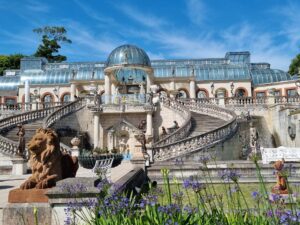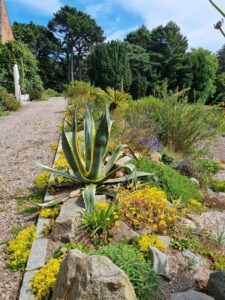
Wedged between the Mourne Mountains and Carlingford Lough, the garden at Ballyedmond has its own microclimate. There have been a lot of changes since the last IGPS visit five years ago. At the rear of the castle the lawn banks have been removed, lots of hard core added and Mediterranean style planting put in. Remarkably, this area has only recorded -1C at its lowest since it has been built. Cycas revoluta, along with other tropical and subtropical plants, thrive here; compare this to Belfast where it resides in the heated Tropical Ravine in the Botanic Gardens.
The seventy acre garden is home to hares, field mice and red squirrels with near black tails. A large wildlife pond has been dug; newts thrive but no frogspawn has been seen yet – probably because they’ve been top of the newts’ menu. Species rich wild flower meadows sweep down to the shores of Carlingford Lough. With more emphasis on encouraging wildlife, haystacks are left for habitats – hopefully hedgehogs will take up residence. Evergreen trees have been planted guarding against another “Beast from the East” storm.

I particularly enjoyed the ‘Leaf Garden’, a garden within a garden. A two metre high Griselinia hedge protects tender plants such as Zinnia, and encloses plants with distinctive foliage e.g. Acacia pravissima, Tetrapanax papyrifer and Amicia zygomeris. It also gave a calm and intimate space. Similarly the stumpery, with a descending path and high sides which allowed the viewer to examine ferns at eye level.
Overall the garden has matured, softening and complimenting the statuary and hard landscape.
Many thanks go to our hostess Lady Ballyedmond, and gardeners Ian, Andrew and Jacob, for making our visit so memorable. I am looking forward to our next visit and the changes it brings.
